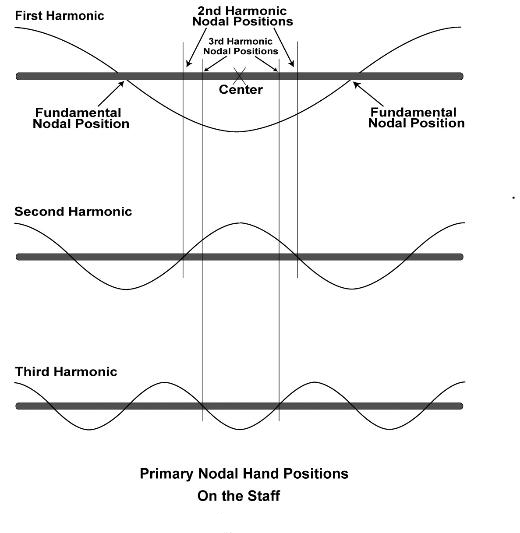
Unlike traditional staff systems such as jojutsu and bojutsu, Aikibojitsu does not strictly prescribe a defined length or diameter for the staff. Choice of staff length instead revolves around the staff's fundamental frequency, the practitioner's height and general level of strength, and the intended use for the staff (walking stick, a staff for practice, a staff to be used as a weapon, or a staff intended for a combination of uses.) As a general rule, Aikibojitsu staff length ranges from a length equal to the measure of the distance between the ground and the practitioner's sternum (roughly the length of an Aikido ‘jo’), to a length equal to the measure of the distance between the ground and the underside of the practitioner's chin, when the practitioner is standing. Choice of a staff depends upon other factors as well. For Short Form and Kata work, a staff should be jo length or a little longer. If waveform practice is the focus, a longer or somewhat more flexible staff may be preferable. For martial applications (self-defense) a shorter staff (jo) of a hard wood like white oak is best because it carries a higher frequency and can thus be manipulated more rapidly. White oak is very tough and won’t break easily, and its hardness allows it to resist dings and abrasions. A jo is also good as a walking stick, because it is not too long. An Aikido jo is fine for general purpose Aikibojitsu practice.
Staff thickness is another factor in staff choice. An overly thick staff is undesirable because it will prove to be cumbersome and relatively inflexible. It won’t carry vibratory curvature well as the excessive thickness limits amplitude of developing waveforms, making precision work with waveforms in practice difficult to unavailable. On the other hand, a staff that is too thin will vibrate at an excessively low frequency and carry waveforms of excessively high amplitude. Such a staff, although capable of clearly showing developing waveforms, has such a low frequency that its waveforms all develop excessively slowly. Worst of all, the lack of strength in the overly thin staff will generally cause it to be quickly broken. The same factor makes an overly thin staff useless as a walking stick or a weapon of self-defense. A reasonable diameter for the staff is based upon type of wood, and staff length. Probably the best range is from 1.75 to 2.50 centimeters, but in general, as long as it is neither ‘too thin’ nor ‘too thick’, staff diameter is somewhat a matter of preference. Aikibojitsu is an archetypal art form that encourages people to train outside, to go on solitary walks, to hike alone in the mountains. Thus, when considering staff length, thickness, flexibility and wood type, it is good to remember that you are choosing a walking stick as well as a potential weapon of self-defense. A good walking stick is about jo length, not much longer, because longer staffs tend to be too unwieldly (a longer staff will be more difficult to fit into a car, for example.) A shorter staff (down to jo length) is a good general choice both as a walking stick, and for the fast manipulation needed for use in self-defense.
Material is another factor to consider in staff choice. The type of wood will affect how the staff carries energy. A wood chosen for a staff should be tough (won’t break easily) and hard (will be resistant to dings and abrasions.)Three commonly used hardwood types are Japanese white oak (the most common jo wood), hickory, and purple heart. For beginning practitoners, probably the best staff (and for advanced practitioners working on staff taking and throwing with the staff) is the common industrial broom handle. Available at janitorial supply houses everywhere, when the ends are cut off and the cut edges lightly sanded, the result is a staff that is tough, resilient, and best of all inexpensive. If it breaks it is not a great loss. The main problem with industrial broom handles is that they can tend to be a little too thick and heavy. Take the time to look through the assortment and pick a thinner one. A disadvantage of the industrial broom handle is that it will only carry clear waveforms if thrown with real power. That isn't a big problem for beginning practitioners when the focus is learning of the basic movement patterns of Short Forms and the katas of the Daiki Taiyu. Start out with an industrial broom handle, and over time you will eventually come into possession of better quality staffs that can be used for more precise waveform study.
In general, the Aikibojitsu practitioner uses a somewhat longer staff for waveform work. The increased length of a longer staff allows waveforms to develop more slowly and with higher amplitude, making them more visible. Skills obtained in waveform work with a longer, heavier staff, can easily be translated into the shorter staff used in the martial interaction. The transition the other way, from shorter to longer staff, will be considerably more difficult. Most Aikibojitsu practitioners have a variety of staves of different lengths and materials, each with its own ‘personality’ selected based upon the type of use intended. Within every staff, even before it is manipulated, multiple standing waveforms of potential exist. These potential waveforms individually and collectively are determinant of the staff's character. Standing waveforms of potential exist within, and hold true for every staff, of any length, diameter or material. Staff work that takes into account the staff's implicit energy patterns will best minimize energy loss, which is key to optimization of technical movement. Work not in accord with the staff's fundamental nature inevitably results in generation of unintended, spurious exponentials, and relatively low levels of manifested power and intensity.
For a discussion of the waveforms that emerge from the staff and the relationship between the practitioner and the Stream of Creation, please see the staff as a resonant entity.

